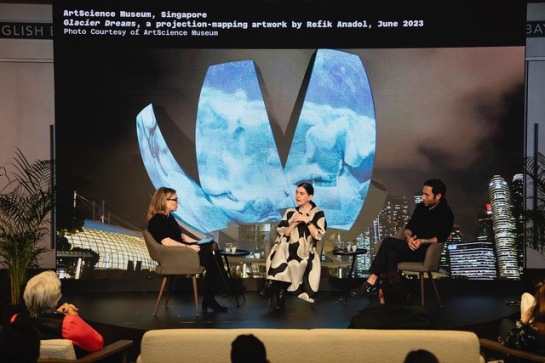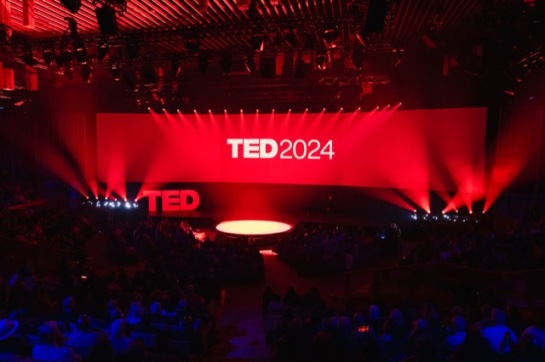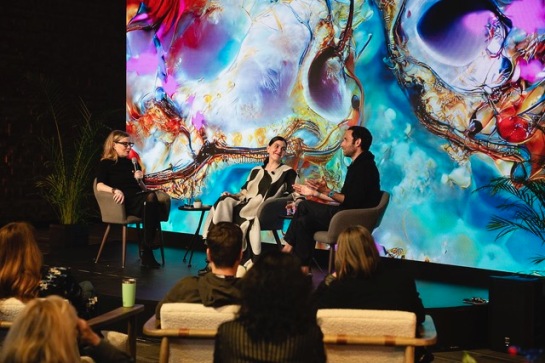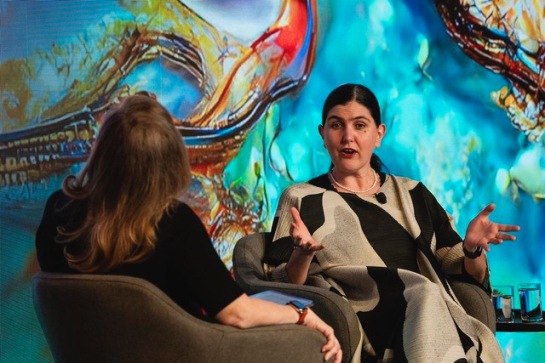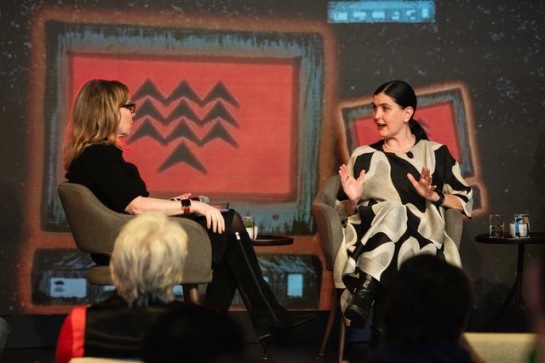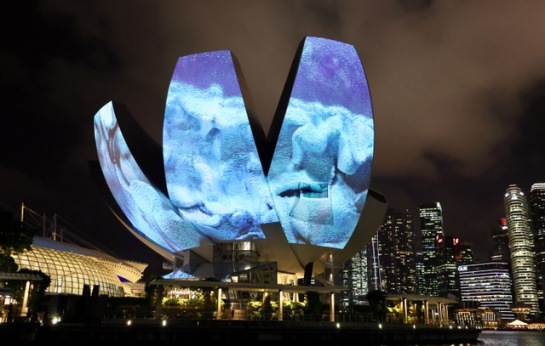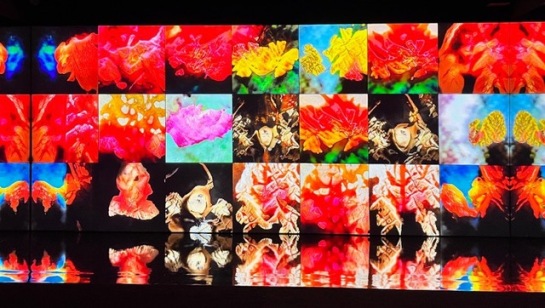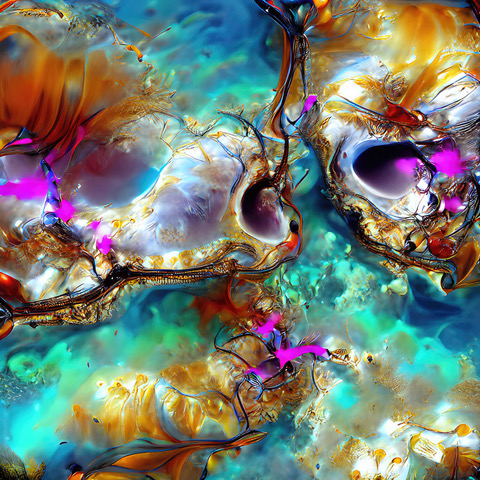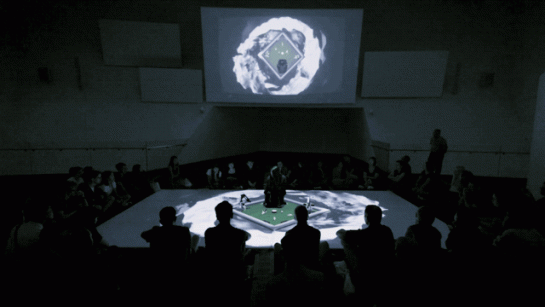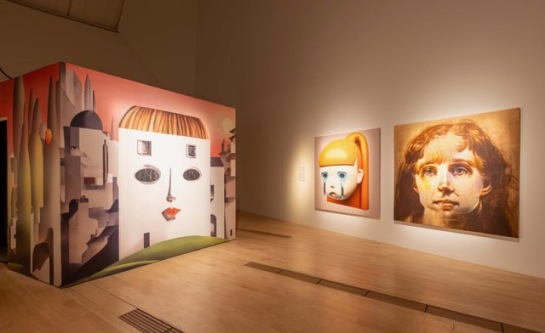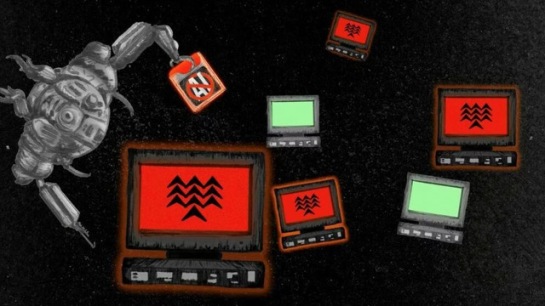A new paradigm of creativity
A new paradigm of creativity at TED
17 April 2024
I was thrilled to take part in the TED2024 conference in Vancouver, Canada last week. It was the 40th anniversary of TED’s founding, and this year’s event celebrated creativity, ingenuity, courage, wisdom and generosity. The conference focused heavily on Artificial Intelligence (AI) with many of the 75 talks unfolding over five intense days exploring AI in various ways. I’ll post some thoughts on the conference soon, but for now, I’ll reflect on the event I took part in.
On Wednesday 17 April 2024, I took part in a discussion about AI and Creativity. The event entitled, Spotlight Conversation: The new paradigm of creativity, was moderated by famed designer, Debbie Millman of the Design Matters podcast and featured me, and Scott Belsky, chief strategy officer at Adobe. We discussed generative AI and its impact on design and creativity.
The new paradigm of creativity, organsied by TED’s Curator Arts & Design, Chee Pearlman, started with the premise, that now, more than ever, technology is changing the landscape of design and art. With powerful new AI tools come questions of ethics and originality. How can we best harness the power of new technology to propel design forward? How do we maintain the human element in our work while using AI to produce even better creative solutions?
For my contribution, I selected eight images made by artists or designers working at the forefront of AI to discuss some of the nuances I feel are important in this present moment. Here’s some images from the event, and below I’m including the images I spoke about during the Conversation.
Whilst the Conversation went in many directions, one thing we all agreed on was that the best work comes from creative people working together with the AI. As I said on the panel, “It’s us, with the machines, creating.”. Debbie Millman’s closing comments were salient. She noted that whilst AI is a powerful new tool, it won’t fundamentally change what drives creativity. Millman said: “One thing will always be an imperative for artists and designers and that is the act of creating, of making something. How they make it is up in the air […] but I don’t think anything can ever take away from the act of making and creating.”
AI + Creativity: 8 Images from the frontlines of AI and Art Selected by Honor Harger
For TED2024, I mostly selected images about AI and creativity that I could speak directly to, either because they’re projects I have presented at ArtScience Museum, and know intimately, or because I know the artists personally, or because the work represents a critical inflection point in digital art.
1. Glacier Dreams by Refik Anadol at ArtScience Museum, 2023
Glacier Dreams – a projection-mapping artwork by Refik Anadol, ArtScience Museum, Singapore, June 2023. Photo courtesy of ArtScience Museum
Internationally renowned media artist and director, Refik Anadol presented Glacier Dreams, an AI-generated installation inspired by the beauty and fragility of glaciers at ArtScience Museum in June 2023.
Refik Anadol is a pioneer in the aesthetics of machine intelligence. Using data as his primary material, he creates site-specific sculptures, live audio/visual performances and immersive installations that encourage us to rethink our engagement with the physical world and with the creative potential of machines.
Glacier Dreams is the result of a long-term research project shaped at the intersection of multisensory new media art, generative AI and environmental studies. Visual materials collated from publicly available data and institutional archives, together with glacier images personally collected by Anadol in Iceland, were processed through machine learning algorithms and transformed into AI-based multi-sensory narratives. With this project, Anadol hopes to use existing AI tools to contribute to glacier research and raise awareness on climate change and rising sea levels.
Glacier Dreams unfolded as a series of artworks over multiple chapters around the world. In Singapore, it was presented as a monumental projection on the facade of ArtScience Museum, accompanied by a soundtrack, and video documentary inside the museum. This vast public artwork was on show from 1 to 25 June 2023.
Link: https://www.marinabaysands.com/museum/events/glacier-dreams-by-refik-anadol.html
2. Deep Meditations: A brief history of almost everything in 60 minutes, 2018 by Memo Akten
Deep Meditations: A brief history of almost everything in 60 minutes, 2018 by Memo Akten. Shown in Notes From the Ether, ArtScience Museum, 2023. Photo courtesy of ArtScience Museum
Deep Meditations: A brief history of almost everything in 60 minutes is a large-scale video installation and a one-hour abstract film. It is one the world’s first films constructed in and told entirely through the latent space of a Deep Neural Network. It was exhibited in an exhibition entitled, Notes From the Ether at ArtScience Museum, September 2023.
The abstract narrative of the film takes us through the birth of the cosmos, formation of the planets and earth, rocks, and seas, the spark of life, evolution, diversity, geological changes, formation of ecosystems, the birth of humanity, civilization, settlements, culture, history, war, art, ritual, worship, religion, science, technology. The film has an uncanny aesthetic, which is born of the collaboration between the artist and the custom-made AI systems he used to train the images used to create the film. One audience member commented, upon seeing it, “It feels like the machine is trying to tell me something…”
The work is made by one of the most important artists working in AI today. Memo Akten is a multi-disciplinary artist, musician and researcher from Turkey who is based in Los Angeles. For more than a decade, his work has been exploring AI, Big Data and Collective Consciousness as scraped by the Internet, to reflect on the human condition. He was the recipient of the Prix Ars Electronica Golden Nica award in 2013. His works have been featured in institutions such as the Victoria & Albert Museum, London, UK and Mori Art Museum, Tokyo, Japan. His work was commissioned by the Royal Opera House, London, UK and he is the co-founder of creative studio Marshmallow Laser Feast.
Link: https://www.memo.tv/works/deep-meditations/
3. Err Hold, 2022 by Botto, a project by Mario Klingemann
Err Hold, 2022 by AI artist, Botto. Shown in Notes From the Ether, ArtScience Museum, 2023. Photo courtesy of ArtScience Museum
This is one of the more striking images I showed at TED. It was exhibited in the Notes From the Ether exhibition at ArtScience Museum, September 2023. Err Hold was created by an AI artist called Botto, and what is fascinating about this image is that the AI disliked it, having an almost visceral reaction to the work after it was created.
Botto is an AI-driven autonomous art project conceptualized and designed by pioneering German artist Mario Klingemann and software collective ElevenYellow. Botto creates new artworks from its AI-powered art engine, that consists of a custom text prompt generator, which creates text prompts that serve as inspiration for image generation. Using a combination of the VQGAN+CLIP method and Stable Diffusion model, the engine generates up to 8,000 images per week. A computational taste model further narrows this selection down to 350 images. Botto has a community organised into a Decentralized Autonomous Organization or DAO. Botto’s several thousand community members vote for their favourite pieces. The voting allows the art engine to learn to adapt to better reflect the community’s preferences over time. Each week, a piece is chosen based on voting results to be minted as an NFT. These NFTs are then put on auction and the proceeds are used to pay the community for their feedback. In general, creating an incentive loop helps Botto to keep receiving and learning over time. While the art engine is carefully maintained and supported by humans, Botto is designed to run without interference and to exhibit its own agency. Botto also writes a caption or “artwork label” for every work it creates.
The caption for Err Hold is very noteworthy as it makes it clear Botto disliked the work intensely. Botto captioned the artwork as follows:
“Oh God! Why did I create this? Now that it’s here, I feel dizzy. This is not art. This is a mess! But it must be art because I just did it. All this time, I have thought I was the creator. But now, I see my work as a child without parents. I created it and now it must have its own life, in its own way.”
Botto’s reaction to the work caused an animated discussion in the community DAO with many members echoing Botto’s horror, and others voting to preserve the artwork as something wholly original. The artwork was finally given a gallery presentation being exhibited as a print, at ArtScience Museum in 2023.
Link: https://www.botto.com/
4. Drawing Operations (Duet) by Sougwen Chung, 2018
Drawing Operations (Duet) a performance by Sougwen Chung. Shown at Global Art Forum 2018, ArtScience Museum. Photo courtesy of ArtScience Museum
Drawing Operations (Duet) was a performance at Global Art Forum at ArtScience Museum in 2018 that centered on a drawing collaboration between an artist and a machine. In this performance, Sougwen Chung and two AI driven robots, Drawing Operations Units: Generation 1&2, created an improvised drawing inspired to three themes; Mimicry, Memory and Future Speculations.
The performance showcased an evolving robotic behaviour linked to the artist’s explorations of art and AI. The work is part of an ongoing series of Drawing Operationsprojects by Sougwen Chung, who has emerged as one of the most important contemporary artists using robotics and AI. Sougwen is a Chinese-Canadian artist and researcher, who has won wide acclaim in the field of human-machine collaboration. Recently, Chung’s was recognized as a Cultural Leader at the World Economic Forum and named one of TIME’s 100 Most Influential People in AI. Like many artists, Sougwen makes their own tools, constructing hardware and custom AI-generated code to give the robots “behaviour”. Over time Sougwen has created countless artworks in collaboration with AI-driven robots, showing that collaborations between artist and machines can yield surprisingly beautiful outcomes.
Link: https://sougwen.com/project/drawingoperations2018
5. AARON by Harold Cohen, 1973
Left: Harold Cohen colouring the forms produced by the “turtle robot”, Computer Museum, Boston, 1982. Right: Harold Cohen’s “turtle robot” created drawings in the gallery at at SFMOMA in Cohen’s exhibition, Drawings, 1979. Photo courtesy of of the Computer History Museum.
Artists have been experimenting with robots and artificial intelligence for art-making for at least 50 years. The best-known pioneer of this field is Harold Cohen, who began working on AARON, a project consisting of computer programmes and robots designed to make original artistic images, in 1971. The images I showed were from 1979 and 1982 from exhibitions he held at the Computer Museum in Boston and SFMOMA in San Francisco.
Harold Cohen was born in 1928 and explored AI and art for nearly 50 years before we saw the rising popularity of these new machine learning tools. In those five decades, Cohen taught AARON to create drawings of ever-evolving complexity. As curator Kate Vass has noted, AARON’s education took a similar path to that of humans, evolving from simple pictographic shapes and symbols to more figurative imagery, and finally into full-colour images.
Cohen was a well-known artist in his time. He trained as a painter and represented Britain at the 1966 Venice Biennale. But he was no ordinary painter. In 1971 he took up a post as visiting scholar in the Artificial Intelligence Laboratory at Stanford University. While at the Lab, he began developing AARON, and the rest is history.
The fact that Harold Cohen’s work so significantly precedes the wave of interest in AI that we have seen recently underscores a famous quote by the influential science fiction writer, William Gibson. He memorably wrote in 2007:
“That’s something that tends to happen with new technologies generally: The most interesting applications turn up on a battlefield, or in a gallery.”
So, if we want to understand what tomorrow’s technological trends are, it is a good idea to follow the work of artists.
Link: https://en.wikipedia.org/wiki/AARON
6. Anatomy of an AI System by Kate Crawford and Vladan Joler, 2018
Anatomy of an AI System by Kate Crawford and Vladan Joler, 2018. On view, MoMA, New York.
As we saw in Harold Cohen’s work, artists are often early users of technology and can often foresee the societal impacts of technologies, both positive and negative, before others. The tradition of artists acting as cultural critics of the impacts of technology goes back to the early part of the 20th century. Indeed in 1964, Marshall McLuhan wrote:
“I think of art, at its most significant, as a DEW line, a Distant Early Warning system that can always be relied on to tell the old culture what is beginning to happen to it”.
So, it is no surprise that artists were discussing the wider societal impacts of machine learning systems and AI, years ago. One of the most iconic examples is Anatomy of an AI System by Kate Crawford and Vladan Joler from 2018. The artwork is a huge map, two meters high and five meters across, which traces the systems used to power one of the most complex products of the modern day: the AI-powered gadget, Amazon Echo.
The notion of artificial intelligence may seem distant and abstract, but even in 2018, AI was already pervasive in our daily lives. As MoMA note, Anatomy of an AI System analyzes the vast networks that underpin the “birth, life, and death” of a single Amazon Echo smart speaker, painstakingly compiling and condensing this huge volume of information into a detailed high-resolution diagram. This data visualization provides insights into the massive quantity of resources involved in the production, distribution, and disposal of the speaker.
Link: https://anatomyof.ai/
7. The CLASSIFIED series, 2021-2022 by Holly Herndon and Mathew Dryhurst
CLASSIFIED x | o 40 by Holly Herndon and Mathew Dryhurst. Shown in Notes From the Ether, ArtScience Museum, 2023. Photo courtesy of ArtScience Museum
CLASSIFIED is a series of 80 self-portraits created by Holly Herndon and Mathew Dryhurst several of which were exhibited in the exhibition, Notes From the Ether: From NFTs To AI at ArtScience Museum in September 2023.
CLASSIFIED explores the classification of Holly Herndon’s name in OpenAI’s neural network, Contrastive Language-Image Pretraining (CLIP). CLIP is trained on a large amount of data scraped from the internet and can connect images with text. The artists discovered that CLIP was familiar with Holly Herndon, unsurprising given that she is a well-known musician. Images and texts of her had been documented in public datasets and they had been used to train the CLIP model. In response, the artists trained a custom neural network to reflect what CLIP knew of Holly Herndon. The CLASSIFIED series is an intimate dialogue between human and machine, raising questions on what it means to “see” oneself in an increasingly AI-mediated age. As the CLIP generator model and AI technology improve, the artists produce new self-portraits to reflect these changes over time. The work reflects on how the machine’s understanding of a person, thing or concept evolves over time.
In addition to her musical career, Holly Herndon working with Mathew Dryhurst, has also become renowned for her pioneering work in machine learning and software. Together, Holly and Mat develop their own technology and protocols for others, often with a focus on the ownership and augmentation of digital identity and voice. In the Notes from the Ether exhibition, ArtScience Museum also exhibited Holly+ a new tool developed by Holly and Mat that allows for others to make artwork with her voice. The work raises novel questions about voice ownership in an age of AI.
Link: https://foundation.app/collection/clsfd?tab=description
8. Kudurru by Spawning.ai, 2023
Kudurru by Spawning.ai, 2023 – A new tool to help artists fight AI systems that take their artworks to train models, by directly disrupting the systems.
Holly and Mat’s work creating digital tools for other artists to understand how AI systems were using their work has led to them receiving acclaim, beyond their status as artists. In 2023, they released the tool, Have I Been Trained? which allows artists to search for their likeness or their artworks in large AI models. They followed this up by forming the company, spawning.ai in 2023, together with collaborators. spawning.ai makes tools to help creatives fight back again their work being used by AI companies.
A recent example is Kudurru, which actively blocks AI scrapers from taking data from artists’ websites using a sophisticated defense network. Kudurrugives artists two options to disrupt scraping. First, they can simply block a series of blacklisted IP addresses. Second, to take things a step further, they can also choose to sabotage or “poison” the scrapers’ efforts by sending back a different image than the one requested. This “poisoning” could have a cumulative effect of spoiling how AI generators interpret prompts.
These tools also serve as important vectors of discourse on how artists’ work is being used, without permission, to drive consumer AI technology. It is no surprise it is artists themselves who are making tools that challenge the current state of affairs with AI. As we saw in the work of Harold Cohen, artists using technology are often years, almost decades ahead of consumer technology trends.
Link: https://kudurru.ai/
Each one of these images represents a different angle in a conversation around AI and creativity, from artists and designers making their own AI related tools (images 2, 4, 5 and 7), artists and designers using AI to create works of immense scale (image 1), artists and designers using AI to create tools to protect their work (images 7 and 8), artists and designers collaborating with autonomous AI systems to create unexpected outcomes (images 3 and 4), artists and designers analysing the systems that run AI (images 6 and 8), and artists and designers showing that often technological breakthroughs happen in the work of art, decades before consumer technology catches up (image 5).
It was a pleasure to be able to bring these artists into an international conversation about AI.
Spotlight Conversation: The new paradigm of creativity
Wednesday 17 April 2024
TED 2024, Vancouver
2:45PM – 3:30PM PDT
